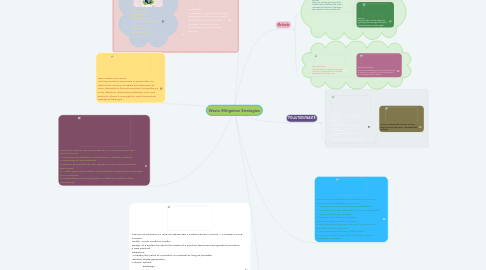Waste Mitigation Strategies
by Claudia Begne


1. CONCEPT: Measures or actions to reduce the impact in the environment by the generation of waste through its reuse, reuse, treatment or final disposal thereof.
1.1. PRINCIPLES: -Prevention. -Responsibility. -Shared responsibility. -Caution. -Proximity and self-sufficiency.
2. PRODUCT RECOVERY STRATEGIES AT THE END OF LIFE / ELIMINATION 1.-Recovery of isolated to reuse them in another product. 2.-Recovery of raw materials 3.-Return the product to the supplier in case it has not been purchased. 4.- Offer discounts so that a new product is acquired in exchange for an old one. 5.-Implantation of recycling bins in different sectors of the community.
3. DEMATERIALIZATION: Use less material resources in production, to reduce the volume of waste and exposure of toxic elements in the environment, promoting a more effective relationship between man and product, where it is sought to use the product instead of having it .
4. CIRCULAR ECONOMY: USE OF RESIDUES AS RESOURCES WITHIN A CLOSED CYCLE SYSTEM. Motto: "From cradle to cradle" Design of a system by which the waste of a product becomes new goods to produce a new product. Objective: -Maintain the value of a product or material as long as possible. -Reduce waste generation. Actions: rethink Redesign Refabricate Repair Redistribute Re-use Recycle Recover energy -Materials can be regenerated instead of discarded after the first use. -Benefits: reduce costs and waste Better risk management when using raw materials. new work sources. New products can be offered at more affordable prices.
5. Methods
5.1. RE-USE: Return to use things to give them another life and that can be used = Decrease the amount of garbage = less impact on the environment.
5.1.1. RECYCLE: -Use processes to reuse the material that is discarded. -Waste of energy -Pollution in reprocess.
5.1.2. REPAIR: Reconstruction of the object by replacing the damaged, broken or old part so that it works again.
5.2. RECONDITION: Rebuild, clean or replace damaged parts of an object so that it has the appearance of being new.
5.2.1. RE-ENGINEERING: Review and redesign of the processes used to reduce the impact on the environment by the generation of waste.
6. POLLUTION/WASTE
6.1. POLLUTION: Generation of toxic gases that go to the environment. Types: -From air -Of the waters (Sea, Rivers, Lakes) -Ground Consequences: -Deterioration of the landscape -Bad smells -Fire hazards due to flammable debris -Proliferation of bacteria and pests.
6.1.1. WASTE: Material that is thrown or from which a person falls apart. Associated with garbage.

